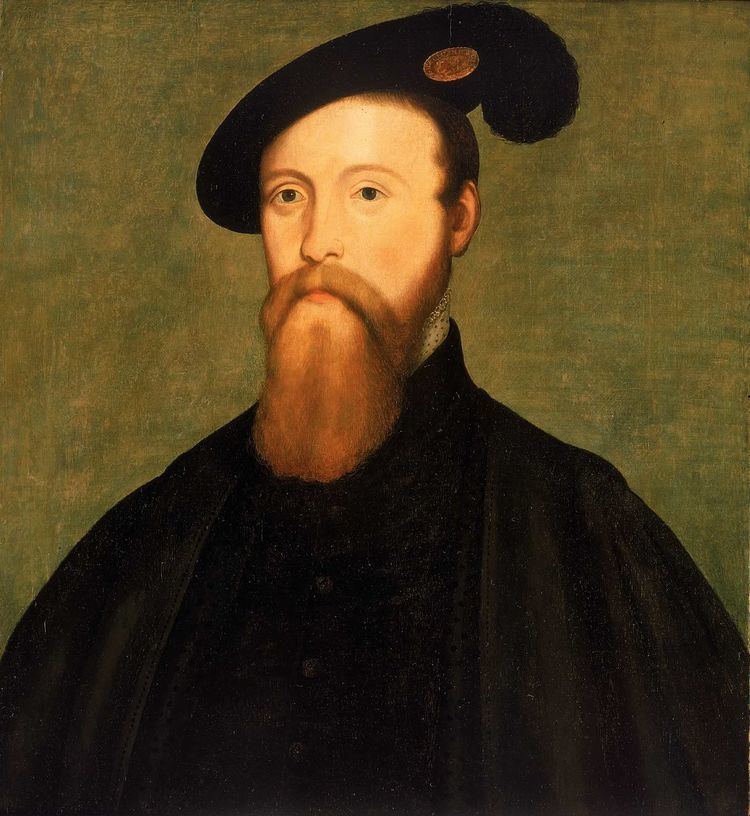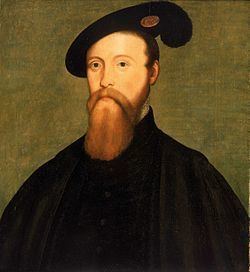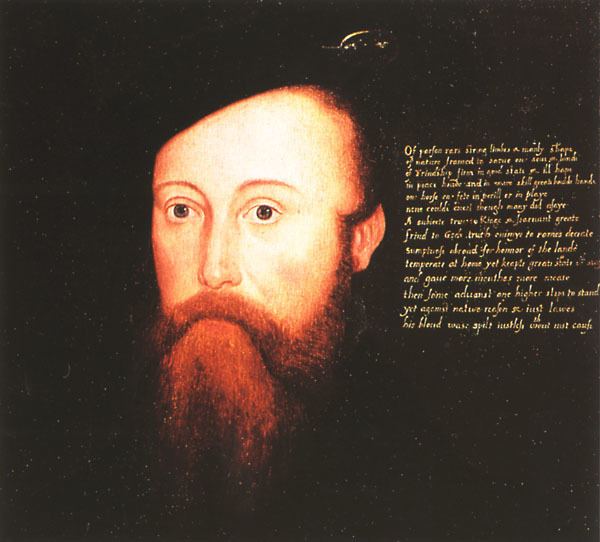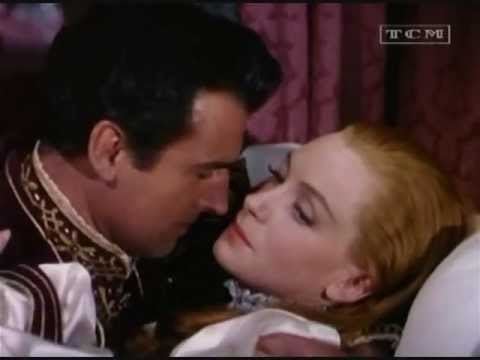Noble family Seymour | Name Thomas 1st | |
 | ||
Father Sir John SeymourMargery Wentworth Buried Chapel Royal of St. Peter ad Vincula, Tower of London51°30′31″N 0°04′37″W / 51.508611°N 0.076944°W / 51.508611; -0.076944 | ||
Catherine parr queen of england and ireland
Thomas Seymour, 1st Baron Seymour of Sudeley, KG (c. 1508 – 20 March 1549) was the brother of the English queen Jane Seymour who was the third wife of King Henry VIII and mother of King Edward VI. He was also the fourth husband of Catherine Parr who was the sixth and last wife of Henry VIII. However, he is probably best known for his influence in the life of the future Queen Elizabeth I.
Contents
- Catherine parr queen of england and ireland
- The tudors reign of edward main titles
- Royal connection
- Foreign affairs
- Regency Council and marriage to Catherine Parr
- Flirtation with Elizabeth
- Relationship with the young king
- Thomas Seymours downfall
- Afterwards
- References

Thomas was the son of Sir John Seymour and Margaret Wentworth. He was the younger brother of Edward Seymour, 1st Duke of Somerset (1500-1552). He grew up at Wulfhall, the Seymour family home, in Wiltshire, a county in southwest England. The Seymours were a family of country gentry, who, like most holders of manorial rights, traced their ancestry to a Norman origin. To his contemporaries, he was forceful and reckless, and also, very attractive to women. Sir Nicholas Throckmorton, a boyhood friend of King Edward, described Thomas Seymour as "hardy, wise and liberal ... fierce in courage, courtly in fashion, in personage stately, in voice magnificent, but somewhat empty of matter." And though ambitious, his brother, Edward Seymour, far surpassed and out-distanced him in their rivalry over control of their nephew, King Edward VI, and for power. Thomas was executed for treason.

The tudors reign of edward main titles
Royal connection

Because Henry VIII and his second wife, Anne Boleyn, did not have a son (Henry hoped for a male heir), his interests turned elsewhere, to Jane Seymour one of Anne's ladies in waiting. Henry married Jane eleven days after Anne's execution in May 1536, and the Seymour brothers saw their fortunes rise, as they became part of the royal family. In October of the following year, Jane gave birth to a son, Edward Tudor, who would become King Edward VI. Less than two weeks later, Queen Jane died from complications related to childbirth, leaving her two brothers, Edward and Thomas, as uncles to the baby Edward, heir to the throne. Therefore, because of this marriage, Thomas Seymour's sister, Jane Seymour, had been queen; his nephew, Edward Tudor, would be king; and his older brother, Edward Seymour, would be Lord Protector, ruler of England, on behalf of the minor King.

Thomas's other royal connection was with Catherine Parr, Henry VIII's sixth wife, whom Thomas would later marry, after Henry's death. The Parrs were a substantial northern family, both of Catherine's parents being friends with King Henry and Queen Catherine of Aragon, (who was Catherine Parr's godmother and Henry's first wife). In 1529, when she was 17, Catherine married Sir Edward Burgh, who died in the spring of 1533, not surviving to inherit the title of Baron Burgh. In 1534 Catherine married John Neville, 3rd Baron Latimer, a man twice her age. With this marriage, Catherine had a secure home, step-children, and a husband with influence and a title. As a result of the uprising of the North, in January 1537, Catherine and her family spent much of their time in London where, in 1542, she became acquainted with Thomas Seymour. Catherine preferred the atmosphere of the court which was very different from the rural estates she had known. She nursed her husband until his death in 1543, which left her a rich widow. After Lord Latimer's death, she faced the possibility of having to return north. However, in that same year, Catherine established herself as part of Princess Mary's household, where she caught the attention of the King, (who had been married two more times since Queen Jane's death). Although she had already begun a romantic relationship with Thomas, she saw it as her duty to accept Henry's proposal over Thomas's. Thus, on 12 July 1543, Catherine Parr became Henry's sixth and final wife.
Foreign affairs

Meanwhile, in 1538, Thomas was sent to the embassy at the French court. He was one of those appointed to meet Anne of Cleves, King Henry’s fourth wife, at Calais on 13 December 1539. A few weeks later he was sent to Ferdinand, King of Hungary and brother of Charles V, Holy Roman Emperor to enlist support for Henry against France and Scotland. He arrived at Vienna in July, and remained there two years. In May 1543, he was appointed ambassador to the Netherlands. He was given this posting to remove him from King Henry's court, for the King’s marriage to Catherine Parr. War breaking out between England and France, Seymour was made marshal of the English army in the Netherlands on 26 June, being second in command to Sir John Wallop. On 24 July 1543, with a strong detachment, he captured and destroyed the castles of Rinquecen and Arbrittayne near the French city of Boulogne. For a short time, he held the chief command during Wallop's illness. Due to his position of privilege as a royal uncle and as a reward for his services, Thomas was made Master-General of the Ordnance in 1544 and Lord Warden of the Cinque Ports in 1545, both very senior military positions.
Regency Council and marriage to Catherine Parr

He returned to court just before King Henry VIII died in January 1547, leaving Catherine one of the wealthiest women in England. According to the King's will, a regency council was constituted to rule on behalf of the 9-year-old orphaned King Edward. As the uncles of the king, both Thomas and Edward Seymour were members of the regency council. As part of an "unfulfilled gifts clause" left unmentioned in Henry's will (and of dubious authenticity), the members of the council granted themselves, on behalf of the king, lavish gifts and titles. Thomas became 1st Baron Seymour of Sudeley. Edward became Edward Seymour, 1st Duke of Somerset, and is often, therefore, referred to as "Somerset." In addition, Thomas saw his brother rise, in the contentious and dangerous politics of the English Reformation, to the position of chief councilor with an approved title of "Protector" regent, referred to unofficially as Lord Protector of England, in effect, ruler of the realm as Regent for his nephew, the king. Thomas, unsurprisingly, began to resent his brother and the relationship between them began to dissolve. Although Thomas was named Lord High Admiral as a concession, he was consumed by jealousy of his brother's power and influence and worked to unseat and replace his brother as Lord Protector.

Thomas Seymour sought to over-turn his brother's position on the regency council by his personal influence over the young king, and also possibly, by making a royal marriage. Although his name had been linked to Mary Howard, Duchess of Richmond, he was still unmarried at the time of the King's death. He had previously shown some interest in marrying either of Henry’s daughters, Elizabeth or Mary; however, within weeks of Henry’s death, Thomas had rekindled the affair with Catherine Parr, and they were secretly married in April or May 1547, too soon after the king's death to suit many. Anne Stanhope, Somerset's proud wife, disliked Catherine and Thomas and began to turn many people in court against them. To demonstrate her hatred, Anne kept the Queen's jewels, which by right were Catherine's. In turn, Catherine was annoyed at the appointment of Edward Seymour (Duke of Somerset) as Protector regent, since as King Edward's stepmother, she had expected to be appointed regent.
Flirtation with Elizabeth
Upon their marriage, Thomas moved into his wife’s house, at Chelsea Manor in London, where she lived with her step-daughter, the 14-year-old Elizabeth. Thomas was the uncle of Elizabeth's half-brother, and the newly wed husband of her step-mother, and their family roles regarding each other were, perhaps, unclear. Now, living under the same roof as Elizabeth, Thomas became more than a little familiar, if not intimate, with Elizabeth, indulging in daily romps with her, tickling her, and slapping her on her behind as she lay in her bed, or coming into her room in his nightclothes. Her governess, Kat Ashley, thought this scandalous, and reported it to Catherine. Indignant, Thomas retorted, 'By God's precious soul, I mean no evil, and I will not leave it!' At first, Catherine dismissed the behaviour as just innocent fun, and even joined in the romps on a few occasions. Elizabeth's feelings regarding this behaviour are unknown, but it was said that she bore Thomas some degree of affection. And though her governess, Kat Ashley, "bade him go away in shame," she found him more amusing than dangerous. When Catherine was pregnant in the spring of 1548, she had become concerned enough about her husband’s flirtatious relationship with Elizabeth that she sent Elizabeth away to live with Anthony Denny and his wife, Joan Champernowne (Kat Ashley's sister), in Hertfordshire. In June 1548, Catherine and Thomas Seymour moved their household from London to Sudeley Castle, the property granted to Seymour when he became Baron Seymour of Sudeley. In September 1548, Catherine gave birth to a daughter, Mary Seymour. In the following days, she became uncharacteristically hostile and delusional. Thomas lay in bed with her to quiet her, but she did not get better, and died of complications due to childbirth, just before Elizabeth’s 15th birthday. Upon her death, Catherine bequeathed all of her possessions to Thomas, making him one of the richest men in England. He said he was "amazed" at her death; yet it opened up new opportunities to him, as his eye returned to Elizabeth. From fear or shrewdness, she avoided him, returning, with her governess, Kat Ashley, to her childhood home, Hatfield House.
Relationship with the young king
Despite his great wealth and high position, Thomas could not come to terms with his brother's appointment as Protector; and in his struggle with Somerset, he tried to ingratiate himself with the king, who was just a little boy. He sought the 9-year-old Edward to write a letter on his behalf in support of his marriage to the dowager queen, Catherine Parr. The letter was obviously dictated by Thomas for Edward's signature and only enraged Somerset. He began to visit Edward frequently, secretly giving him an extravagant allowance of coins, so that Edward might be satisfied in feeling more grown-up and more king-like, giving gifts to his servants, teachers, and friends. Even though he lived in sumptuous splendor, and wanting for nothing, no provisions had been made for Edward's pocket money and he became accustomed to these regular payments and began to ask Thomas freely for his allowance. Thomas continued his manipulation of the king. In trying to get a bill through Parliament making him Edward's personal Governor, Thomas requested Edward's royal signature on the bill. But Edward was uncertain, and reluctant to go behind the back of the Protector, Somerset, and of the regency council, and he would not sign it. Thomas persistently pressured Edward, until Edward felt threatened. But Thomas did not give up. He tried to persuade Edward that he did not need a Protector, getting Edward to admit that it might be better for Somerset to die. It is not known what the king meant by this, but it was probably uttered innocently. Thomas intended that the king's royal signature and personal support would destabilize Somerset's position as Protector, and as a member of the regency council. In his frustration and inability to gain any significant influence over the king, Thomas began to think in terms of open rebellion. Although he was a boy, King Edward did not seem completely naïve regarding any of this. For, it is recorded that Edward referred to William Parr, his step-mother's brother, as "mine honest uncle," indicating unspoken scorn for both of his Seymour uncles..
Thomas Seymour's downfall
When Lord Somerset, the Protector, invaded Scotland in the summer of 1547 and was absent from court, his brother, Thomas, fomented opposition to his authority, voicing open disapproval of his brother's administrative skills. Because his activities seemed suspicious, several members of the nobility advised him to be content with his position, but he would not listen. As Lord High Admiral, he was able to control the English navy, and he openly asked for support in case of a rebellion. He entered into relations with pirates on the western coasts, whom it was his duty as Lord High Admiral to suppress, with a view to securing their support. Thomas seems also to have hoped to finance a rebellion through crooked dealings with the vice-treasurer of the Bristol Mint, Sir William Sharington.
By 1548, the regency council was becoming aware of Thomas's bid for power. Somerset tried to save his brother from ruin, calling a council meeting so that Thomas might explain himself. However, Thomas did not appear. On the night of 16 January 1549, for reasons that are not clear (perhaps to take the young king away in his own custody), Thomas was caught trying to break into the King's apartments at Hampton Court Palace. He entered the privy garden and awoke one of the King's pet spaniels. In response to the dog's barking, he shot and killed it. The next day, he was arrested and sent to the Tower of London. The incident, being caught outside the king's bedroom, at night, with a loaded pistol, was interpreted in the most menacing light, even casting suspicion on Elizabeth's involvement with Thomas. On 18 January, the council sent agents to question everyone associated with Thomas, including Elizabeth. On 22 February, the council officially accused him of thirty-three charges of treason. He was convicted of treason, and condemned to death and executed on 20 March 1549.
Afterwards
When he was arrested for treason, Seymour's associates were also cast under suspicion, including 15-year-old Elizabeth. Distraught over Thomas’s arrest, she did not realize her own danger until her servants, including her beloved governess, Kat, were also arrested. Upon realizing that Thomas would probably be executed, she was noticeably disconsolate, trying to free herself and her servants from suspicion. The regency council was sure of her complicity with Thomas, and sought to bully an easy confession from her. She was interrogated relentlessly for weeks. But the council found itself in a sharply defined game of wits with Elizabeth, who proved to be a master of logic, defiance, and shrewdness. The embarrassing details of the flirtatious incidents with Thomas came to light. But there was no evidence that Elizabeth had conspired with him.
This incident was a sign of Elizabeth's strong and distinctive personality. This difficult experience seems to have made her, for the first time in her young life, fully aware of the serious, even deadly, nature of her succession rights to the throne. When she made her first public appearance at court 18 months later, just turning 17, she dressed in a simple, somber manner with plain and unadorned hair. This contrasted sharply with the showy splendor of the other ladies present, as if she was trying to live down the scandal of her association with Thomas.
After his execution, all of Thomas’ property was seized by the Crown.
